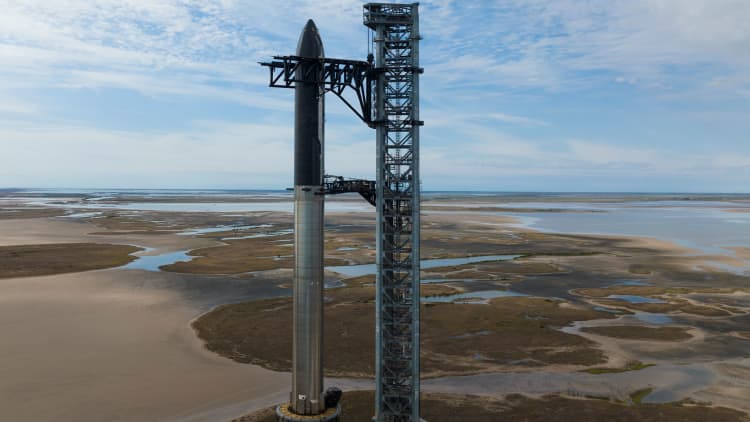ARTICLE AD BOX
SpaceX is set to launch its sixth test flight of its Starship rocket on Tuesday, as the company looks to keep up momentum of the mammoth vehicle's development.
The company has a 30-minute window, from 5 p.m. ET to 5:30 p.m. ET, to launch Starship from its private "Starbase" facility near Brownsville, Texas. If SpaceX is unable to launch within that window for weather or technical reasons, the company will postpone the attempt to a later date.
There will not be any people on board the Starship flight.
SpaceX's next-generation Starship spacecraft atop its powerful Super Heavy rocket is prepared for launch at the company's Boca Chica launchpad, near Brownsville, Texas, U.S., November 16, 2024.
Joe Skipper | Reuters
Assuming the launch goes according to plan, Starship would reach space and then travel halfway around the Earth before reentering the atmosphere and splashing down in the Indian Ocean. Additionally, the rocket's "Super Heavy" booster would return after separating from Starship and land on the arms of the company's launch tower.
As with each previous test flight, SpaceX aims to push development further by testing additional Starship capabilities, including reigniting an engine while in space and testing its heatshield while reentering the atmosphere.
Additionally, the evening launch time means that this will be the first time Starship makes a daylight splashdown.
SpaceX typically has a cadre of VIPs to view Starship launches and, with CEO Elon Musk's close relationship with President-elect Donald Trump, the sixth flight is no different. Trump is expected to attend the launch on Tuesday, similar to when he came to watch SpaceX's first astronaut launch in Florida in 2020 during his first administration.
Pushing the envelope
SpaceX catches the first-stage "Super Heavy" booster of its Starship rocket on Oct. 13, 2024.
Sergio Flores | Afp | Getty Images
SpaceX has flown the full Starship rocket system on five spaceflight tests so far since April 2023, at a steadily increasing cadence. Its previous launch last month featured the dramatic first catch of the rocket's more than 20-story tall booster.
After the successful fifth flight, the Federal Aviation Administration confirmed that SpaceX was authorized to move forward with the sixth flight.
But, as with its previous test flight, the fifth launch was not without incidents. SpaceX management, in audio posted after the launch on social media by Musk, revealed that Starship's booster nearly missed the catch due to a timing issue with one of the rocket's subsystems.
"We were one second away from that tripping and telling the rocket to abort and try to crash into the ground next to the tower instead of [landing at] the tower — like, erroneously tell a healthy rocket to not try that catch," an unidentified person told Musk in the audio.
SpaceX will attempt the booster catch again, with the company saying on its website that it has made hardware upgrades to the rocket's booster for improved redundancy and improved structural strength.
Read more CNBC space news
The Starship system is designed to be fully reusable and aims to become a new method of flying cargo and people beyond Earth. The rocket is also critical to NASA's plan to return astronauts to the moon. SpaceX won a multibillion-dollar contract from the agency to use Starship as a crewed lunar lander as part of NASA's Artemis moon program.
Starship is both the tallest and most powerful rocket ever launched. Fully stacked on the Super Heavy booster, Starship stands 397 feet tall and is about 30 feet in diameter.
The Super Heavy booster, which stands 232 feet tall, is what begins the rocket's journey to space. At its base are 33 Raptor engines, which together produce 16.7 million pounds of thrust — about double the 8.8 million pounds of thrust of NASA's Space Launch System rocket, which launched for the first time in 2022.
Starship itself, at 165 feet tall, has six Raptor engines — three for use while in the Earth's atmosphere and three for operating in the vacuum of space.
The rocket is powered by liquid oxygen and liquid methane. The full system requires more than 10 million pounds of propellant for launch.










 English (US)
English (US)